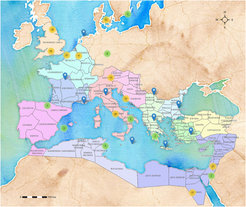IsoArcH.eu: A new open-access isotope database for bioarchaeological samples
IsoArcH www.isoarch.eu is a new open-access and collaborative isotope database for bioarchaeological samples (humans, animals, plants and organic residues) from the Graeco-Roman world (sensu lato) and its margins. It covers the period from the Iron Age to the end of the Late Antiquity/the Early Middle Age (i.e. from 12th c. BC to 8th c. AD).
August 30, 2017

Example of a map generated through IsoArcH showing the distribution of Roman sites with available isotopic data.
Isotopic proxies are widely recognized as a powerful tool to improve knowledge of past human and animal diet and mobility patterns, to ascertain ancient crop and animal management practices, and to reconstruct paleoenvironments. However, the number of isotope web databases remains surprisingly low.
A paper authored by KevinSalesse, Ricardo Fernandes, Xavier de Rochefort, Jaroslav Brůžek, Dominique Castex, and Élise Dufour describes IsoArcH, a new web-based database of isotopic data for bioarchaeological samples from the Graeco-Roman world and its margins. IsoArcH was designed as a cooperative platform for the dissemination of isotopic data and associated archaeological information. IsoArcH follows the open access model and is freely accessible online (http://www.isoarch.eu). Created for paleodietary, paleomobility and paleoenvironmental reconstruction research purposes, IsoArcH compiled to this day published isotopic data for human, animal, and plant remains, as well as organic residues, from nearly 300 sites. All data have been georeferenced allowing for their display on ancient world maps and placement into their contemporaneous geopolitical background. In this paper, several data-driven examples are shown to illustrate the research potential offered by IsoArcH.
IsoArcH is part of the Big isotope Data initiative IsoMemo (http://www.isomemo.com/). The IsoMemo initiative brings together multiple repositories of stable isotope data within the fields of archaeology, ecology, and environmental & life sciences. The goals of the initiative are to establish common data standards, sharing and centralizing data, creating tools such as user friendly graphical interfaces for simple upload and download of data, and building interdisciplinary projects.
